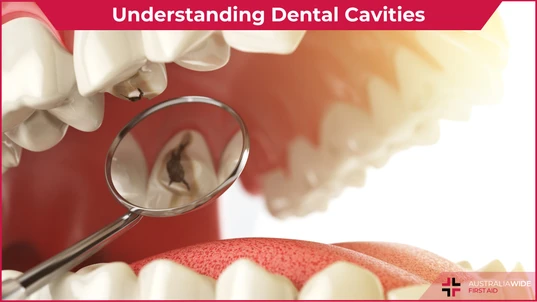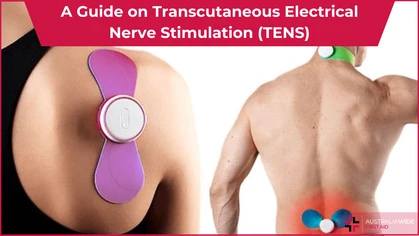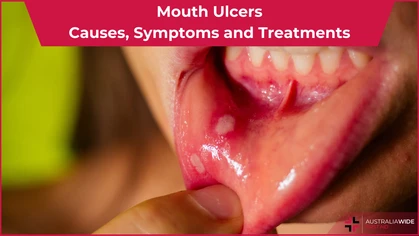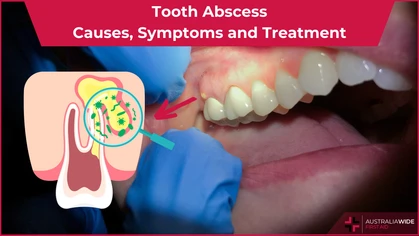Understanding Dental Cavities: Causes, Symptoms, and Treatment Options

General Health-Related
 Dental cavities, also known as tooth decay or caries, are a widespread dental issue affecting individuals of all ages globally.
Some studies suggest that nearly one-third of the adult Australian population suffers from dental cavities. Despite advancements in dental care, cavities remain a significant concern.
This article will look into the causes, symptoms, and various treatment options available for dental cavities.
Dental cavities, also known as tooth decay or caries, are a widespread dental issue affecting individuals of all ages globally.
Some studies suggest that nearly one-third of the adult Australian population suffers from dental cavities. Despite advancements in dental care, cavities remain a significant concern.
This article will look into the causes, symptoms, and various treatment options available for dental cavities.
Causes of Dental Cavities
Dental cavities are the result of a complex interplay of factors, primarily involving the interaction between oral bacteria, sugars from the food we eat, and the structure of teeth. The human mouth harbours a diverse community of bacteria. While most of these bacteria are harmless and commensals to the mouth, some are disease-causing under the right conditions. Among these, Streptococcus mutans and Lactobacillus species play a pivotal role in cavity formation. These bacteria produce acids during the breakdown of sugars, leading to enamel erosion. The consumption of sugary or starchy foods and beverages provides the bacteria in the mouth with the necessary substrates to produce acids. Frequent ingestion of these items can elevate the risk of cavities. Inadequate brushing and flossing further permit the accumulation of plaque, a sticky film composed of bacteria and food particles, on tooth surfaces. The build-up of plaque accelerates the decay process by creating a favourable environment for harmful bacteria. Saliva plays a vital role in neutralizing acids, cleaning the teeth, and remineralizing teeth as it contains fluoride. Conditions that reduce saliva production, such as certain medications or medical conditions, can increase the susceptibility to cavities. Some individuals have deep pits and fissures on their teeth, making it easier for plaque to accumulate in hard-to-reach areas. These areas tend to be more susception to caries as they are often difficult to clean and harbour food debris.
Tooth pain can be an indication of a cavity, even if you can't see one.
Symptoms of Dental Cavities
Early recognition of the signs and symptoms of dental cavities is crucial for preventing further progression and extensive damage. Some of the most common symptoms of dental cavities. Initial and advanced are described below.- Toothache: A persistent, throbbing pain in the affected tooth is often the initial indication of a cavity.
- Tooth Sensitivity: Teeth may become sensitive to hot, cold, sweet, or acidic foods and drinks.
- Visible Holes or Pits: As cavities progress, they can create visible holes or pits on the tooth's surface.
- Discolouration: Cavities can result in white, brown, or black spots appearing on the tooth's surface.
- Halitosis (Bad Breath): Bacteria within cavities can produce malodorous gases, leading to bad breath.
- Bad taste: Advanced cavities may lead to dental abscesses, which may contribute to a bad taste in the mouth, especially when the pus leaks out. This is a sign of a dental emergency, and you need to visit a professional promptly.
Treatment Options for Dental Cavities
Effectively treating dental cavities is essential to prevent further deterioration and maintain oral health. The choice of treatment depends on the cavity's size and severity. Some of the most common treatments available include: Dental Fillings For small to moderately sized cavities, dentists typically remove the decayed portion of the tooth and fill the void with materials such as silver amalgam (now outdated), composite resin (tooth-coloured), or glass ionomer cement. These fillings restore the tooth's shape and functionality. Root Canal Therapy When a cavity has reached the tooth's pulp (innermost part), it can lead to severe pain and infection. Root canal therapy involves the removal of the infected pulp, cleaning of the root canals, and sealing the tooth. The treatment usually requires 3 to 4 visits. Dental Crowns In cases where a cavity has extensively weakened the tooth structure, a dental crown may be necessary. Crowns are custom-made caps that cover the entire tooth, providing strength and protection. Fluoride Treatment During the early stages of cavity development, fluoride applications can assist in remineralizing the enamel and reversing the damage. It further strengthens the tooth and enables them to resist decay. Preventive Measures Practicing good oral hygiene, reducing sugar consumption, and scheduling regular dental check-ups are essential for preventing cavities. Sealants, a protective coating applied to the chewing surfaces of molars, can also reduce cavity risk, particularly in children.Conclusion
Dental cavities, or tooth decay, result from various factors, including oral bacteria, dietary choices, and oral hygiene habits. Recognizing the symptoms and seeking timely treatment is vital for preventing further damage. Treatment options range from simple fillings to more complex procedures like root canal therapy. Therefore, it is recommended for you to visit your dentist every 6 months for a proper oral health check-up. These check-ups help you stay at the top of your oral health and enable you to get any oral health diseases treated at the earliest. Apart from this, maintaining good oral hygiene and making healthy dietary choices are key to preventing cavities and promoting long-term dental as well as systemic health.
Originally published at
https://www.australiawidefirstaid.com.au/resources/understanding-dental-cavities
as part of the Australia Wide First Aid Articles Library









